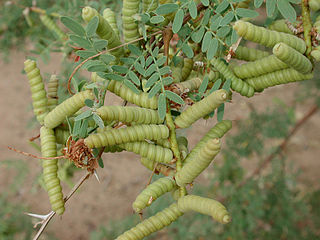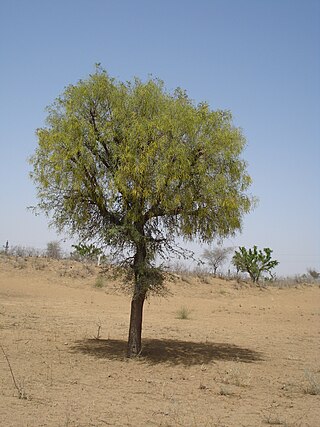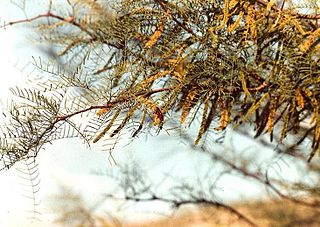
Mesquite is a common name for some plants in the genus Prosopis, which contains over 40 species of small leguminous trees. They are native to dry areas in the Americas. They have extremely long roots to seek water from very far under ground. As a legume, mesquites are one of the few sources of fixed nitrogen in the desert habitat. The trees bloom from spring to summer. They often produce fruits known as "pods". Prosopis spp. are able to grow up to 8 metres (26 ft) tall, depending on site and climate. They are deciduous and depending on location and rainfall have either deep or shallow roots. Prosopis is considered long-lived because of the low mortality rate after the dicotyledonous stage and juveniles are also able to survive in conditions with low light and drought. The Cahuilla indigenous people of western North America were known to eat the seeds of mesquite.

Prosopis is a genus of flowering plants in the family Fabaceae. It contains around 45 species of spiny trees and shrubs found in subtropical and tropical regions of the Americas, Africa, Western Asia, and South Asia. They often thrive in arid soil and are resistant to drought, on occasion developing extremely deep root systems. Their wood is usually hard, dense and durable. Their fruits are pods and may contain large amounts of sugar. The generic name means "burdock" in late Latin and originated in the Greek language.

Neltuma juliflora is a shrub or small tree in the family Fabaceae, a kind of mesquite. It is native to Mexico, South America and the Caribbean. It has become established as an invasive weed in Africa, Asia, Australia and elsewhere. It is a contributing factor to continuing transmission of malaria, especially during dry periods when sugar sources from native plants are largely unavailable to mosquitoes.

Prosopis alba is a South American tree species that grows in central Argentina, the Gran Chaco ecoregion, and part of the Argentine Mesopotamia, as well as Bolivia, Chile, Paraguay, and Peru. It is known as algarrobo blanco in Spanish. Spanish settlers gave it that name because of its similarity to the European carob tree. Other common names come from Guaraní, including ibopé and igopé.

Prosopis nigra is a South American leguminous tree species that inhabits the Gran Chaco ecoregion, in Argentina and Paraguay. It is known as algarrobo negro in Spanish, which means "black carob tree". It is also variously called algarrobo dulce, algarrobo morado and algarrobo amarillo.

Strombocarpa pubescens, commonly known as screwbean mesquite, is a species of flowering shrub or small tree in the pea family, Fabaceae, that is native to the southwestern United States and northern Mexico.

Prosopis pallida is a species of mesquite tree. It has the common names kiawe, huarango and American carob, as well as "bayahonda", "algarrobo pálido", and "algarrobo blanco". It is a thorny legume, native to Colombia, Ecuador and Peru, particularly drier areas near the coast. While threatened in its native habitat, it is considered an invasive species in many other places.

Neltuma glandulosa, formerly Prosopis glandulosa, commonly known as honey mesquite, is a species of small to medium-sized, thorny shrub or tree in the legume family (Fabaceae).

Prosopis laevigata, commonly known as smooth mesquite, is a species of flowering tree in the pea family, Fabaceae, that is native to Mexico, Bolivia, Peru, and north-western Argentina. In Mexico, the species is found in the nation's the central highlands, the lowlands of southern Tamaulipas, and in parts of Oaxaca, Morelos, Puebla, and Chiapas. It grows on a variety of sites on hillslides, in depressions, and along floodplains. It has been spotted growing in the Middle East as well.

Pampa del Tamarugal National Reserve is a nature reserve of northern Chile's Tarapacá Region located in the Pampa del Tamarugal, about 70 km (43 mi) east of Iquique.

Mesquitol is a flavan-3-ol, a type of flavonoid.
Prosopis humilis, the algarrobilla or algaroba, is a mesquite, a flowering plant and a tree species in the genus Prosopis found in Argentina.

Prosopis cineraria, also known as ghaf, is a species of flowering tree in the pea family, Fabaceae. It is native to arid portions of Western Asia and the Indian Subcontinent, including Afghanistan, Bahrain, Iran, India, Oman, Pakistan, Saudi Arabia, the United Arab Emirates, and Yemen. Its leaves are bipinnate. It can survive extreme drought. It is an established introduced species in parts of Southeast Asia, including Indonesia.
Somb is a town in Senegal situated in the west of the country.

Anonychium is a genus of plant in the pea family (Fabaceae). It includes a single species, Anonychium africanum, a tree native to northern Sub-saharan Africa from Mauritania to Uganda and to Saudi Arabia. It is known by the synonym Prosopis africana, and its common names include African mesquite, iron tree, gele, okpehe, and somb tree. Okpehe is the name given by the Idoma and Igala people of Nigeria to both the tree and its fermented seeds. All of the other derivatives such as okpeye and okpiye stem from the noun okpehe used by the Idoma and Igala people of present day Benue State of Nigeria.

Onciderini is a tribe of longhorn beetles of the subfamily Lamiinae, they are prevalent across Europe in nations such as Turkey, and Finland.

Oncideres is a genus of longhorn beetles of the subfamily Lamiinae, containing more than 120 species in the nearctic and neotropics.

Prosopis chilensis is a species of tree in the genus Prosopis, belonging to the family Fabaceae. It is found in parts of central Chile, southern Peru, Bolivia, and Andean (northwestern) Argentina. Its common names include Chilean mesquite, cupesí, and Chilean algarrobo. It is used for providing shade, for animal feed, and firewood.

Oncideres pustulata is a species of beetle in the family Cerambycidae. It was described by John Lawrence LeConte in 1854. It is known from Mexico and the United States. It feeds on Leucaena leucocephala, Leucaena pulverulenta, Prosopis alba, and Prosopis chilensis.














